Annual report on procurement activity in Scotland: 2019
An overview of public procurement activity in Scotland, based on information contained in individual procurement reports prepared by public bodies.
4. Summary of public procurement activity in Scotland
With procurement spending across the public sector in Scotland running in excess of £11 billion a year, procurement is a powerful tool making a significant contribution to Scotland's economy
It is estimated[4] that procurement spending[5] by the Scottish public sector generated around £10 billion of economic activity[6] in the wider Scottish economy. It supported around 100,000 Full-Time Equivalent (FTE) jobs (around 70,000 directly).
The impacts of Scottish public sector procurement spend on the Scottish output, GDP and FTE employment represents around 4% of the total Scottish economy.
What this means is that the value and benefits of goods, services and works procured in Scotland by the Scottish public sector represents a sizeable part of the Scottish economy. To give an idea of the scale of these impacts, the number of jobs supported by Scottish public sector procurement spend is on a par with employment in the whole of the City of Dundee[7], or with the number of people employed in the Financial and Insurance Activities sector[8].
Figure 3: Employment by Sector (BRES 2017)
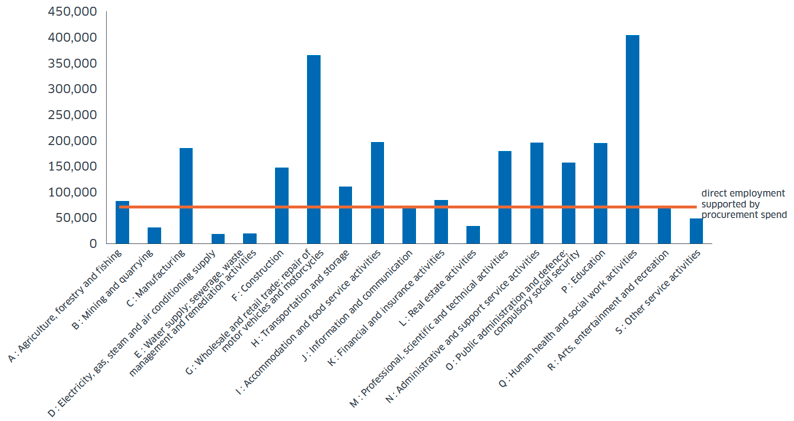
Summary of regulated procurements
Information taken from the 115 annual procurement reports submitted by public bodies across Scotland during the period covered by this report shows the level of public procurement activity and spend on goods, works and services.
In total, 5,782 regulated[9] contracts were awarded by the 115 public bodies during the period covered by this report. The total combined value of regulated contracts awarded, where this is known from the individual annual reports, was £11.2 billion[10]. This is different to spend figures, which will include spend on contracts placed prior to the timeframe reported by public bodies.
Type of contracts
Examples of the types of regulated procurements carried out by public bodies in different sectors are described below:
- In the health sector – primary healthcare, laundry, vehicles, IT hardware, software and support, property maintenance, health promotion initiatives, construction of new hospitals and facilities, and medical supplies and equipment such as medicines, x-ray units, dental equipment, surgical tools and microscopes
- In local government bodies – residential care for children, social care, processing of recyclable waste, public transport, event management, homeless accommodation, library books, property maintenance, new-build housing and roads maintenance
- Among Registered Social Landlords – new build housing, gas heating servicing and maintenance, painting, cleaning, landscaping, furniture, electricity supply, floorcoverings and IT services
- Among central government and other significant national bodies[11] – IT software, hardware and support, printing and publishing, interpretation and translation, office equipment, clothing, vehicles, mobile phones, employability services, laboratory equipment and property maintenance
- For universities and colleges – student travel services, scientific equipment, IT systems, insurance, catering services, virtual classroom software, property maintenance, refurbishment and construction, banking services, childcare and internet provision
The diverse scope of the goods, services and works procured by public bodies across Scotland further underlines the reach of public procurement.
By publishing a summary of regulated procurements completed within their annual procurement reports, public bodies in Scotland are building on work already undertaken to improve transparency and visibility. For example, the 2014 Act required public bodies in Scotland to have a published contracts register in place by April 2016. Our legislation pre-empted a communication[12] by the European Commission published in 2017 in which it strongly recommended setting up publically accessible contracts registers. This is an example of why Scotland is seen as a role model by other countries.
Procurement spend data
An analysis of procurement spend data is helpful in understanding the scope and reach of public procurement in Scotland. For example, over 20,700 businesses in Scotland directly benefited from our procurement spend, approximately 19,500 (94%) of which were SMEs, with many more businesses indirectly benefiting within our supply chains.
Spend by sector
The latest data on procurement spend shows that spend by local government accounts for 55% of all spend recorded on the Scottish
Procurement Information Hub[13]. The proportion of spend by sector has remained fairly consistent since 2015.
Figure 4: Public sector spend (by sector) 2017-18
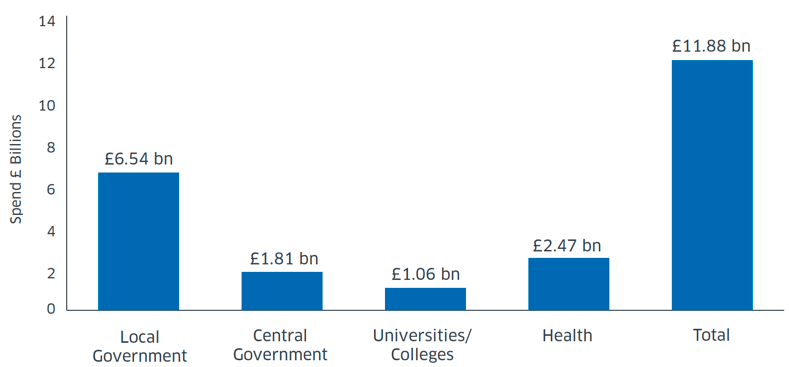
Spend with suppliers in Scotland by category
Figure 5 describes the category (e.g. construction) spend by public bodies with suppliers in Scotland. Overall these figures have remained broadly consistent from 2015 to 2018. Some notable changes are spend on construction falling by 4.7% and spend on
social care and services rising by 21.7% (figure 5). Spend on waste and environmental services has also increased by 26.1% and spend on businesses in the financial sector has also seen a sharp rise of 37.5% although overall spend remains relatively low.
Figure 5: Spend with suppliers in Scotland by category
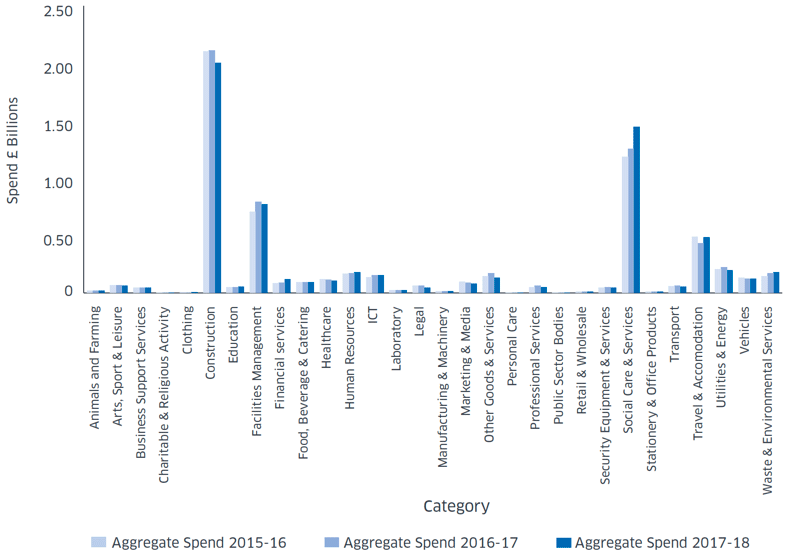
Figure 6: Scottish public bodies procurement spend by supplier location 2017-18
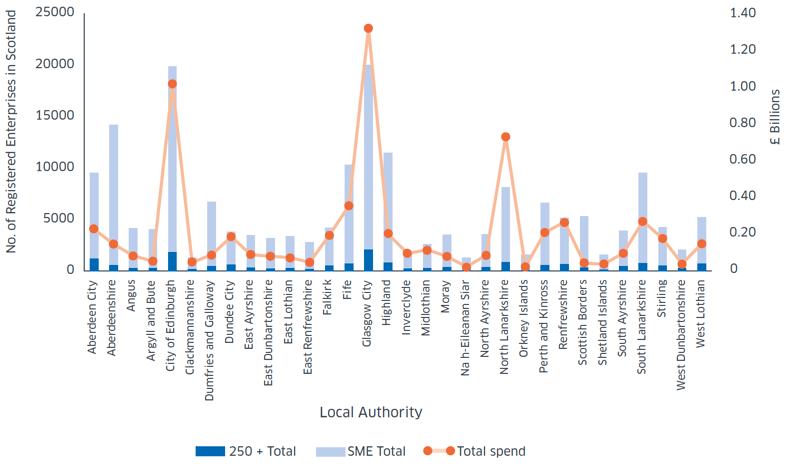
Spend by supplier location
Comparing area procurement spend with the number of registered SME and large enterprises in those areas (e.g. suppliers based in a local authority area) from 2015-16 to 2017-18 suggests that neither the number of registered enterprises nor procurement spend with suppliers in each local authority area have significantly changed over the period (Figure 6).
The procurement spend with suppliers by supplier location is roughly in line with the number of registered enterprises in that area, for example, Glasgow City and the City of Edinburgh areas have the greatest proportion of spend, together with the largest numbers of SMEs and large enterprises. There are some outliers however, in local authority areas such as Aberdeenshire and Highlands there are high numbers of enterprises (13,900 SMEs in Aberdeenshire and 10,965 in Highland), yet businesses in these areas receive lower procurement spend in comparison (£141.2 million in Aberdeenshire and £195.9 million in Highland) (Figure 6).
The North Lanarkshire area in particular received a large proportion of spending (£726.3 million) in contrast to the number of SMEs and large enterprises in the area. In the year end 2018, the North Lanarkshire area had 515 large enterprises registered and 7,605 SMEs, whereas the Aberdeenshire area had 285 large enterprises registered and 13,900 SMEs with only £141.2 million procurement spend (Figure 6).
We recognise that not all businesses will be interested in doing business with the public sector. For example, while there are approximately 176,000 registered businesses in Scotland[14], there are under 66,000 unique suppliers registered on Public Contracts Scotland as expressing an interest in winning public sector contracts. We will continue to support those who are interested in doing business with the public sector in Scotland by offering advice and guidance, by making it easier for them to identify, access and compete for public sector contract opportunities, and by clearly articulating what we expect from our suppliers as responsible and fair employers and key partners.
Spend by supplier type
Figure 7 shows the percentage of the total business turnover in Scotland by business size compared with the proportion of procurement spend by business size.
When procurement spend figures with suppliers located in Scotland are considered relative to the proportion of total Scottish turnover accounted for by different sized firms, SMEs account for a higher proportion of procurement spend (60.1%) than they do of total Scottish business turnover (41.5%).[15]
This suggests that small businesses are proportionally represented by procurement spend at 26.5% (£1.5 billion) when compared to the proportion of turnover at 27.3% (£73.2 billion) accounted for by small businesses. Medium enterprises account for 14.2% of total turnover (£37.9 billion), but 33.6% of Scottish public bodies' procurement spend (£1.9 billion).
Figure 7: Scottish Public Bodies’ Procurement Spend by Size of Business (No. Employees), as a Proportion of Total Turnover in Scotland 2017-18
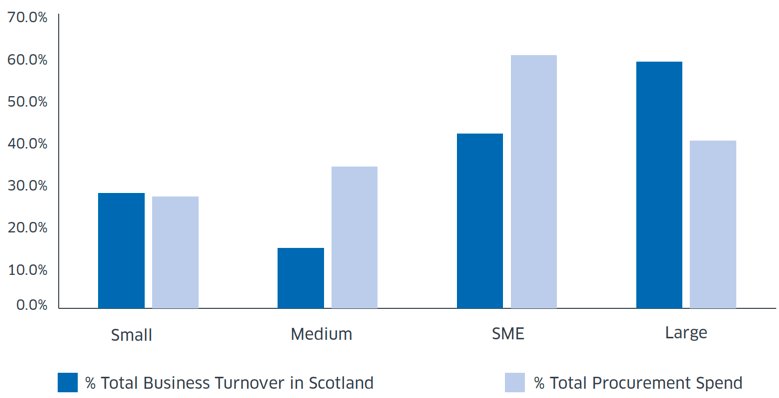
The converse is true for large businesses when taking account of their proportion of total turnover in Scotland. Large businesses of 250 employees and more generate 58.5% of Scotland's turnover (£156.8 billion), yet receive 39.8% of total procurement spend (£2.3 billion) in the period 2017-18.
Procurement spend with large enterprises has declined by 2.3% over a three year period, whereas spend with small and medium enterprises has increased by 0.3% and 1.9% respectively. The proportion of turnover, however, has also declined for large businesses by 1% over this time period. The proportion of Scottish turnover created by small enterprises has increased by 0.1%, while medium enterprises have seen a 0.9% increase. SMEs saw an increase of 1% of turnover in this period alongside a 2.3% increase in procurement spend.
Procurement savings data
Many public bodies reported savings such as efficiency savings, value for money and non-cash savings in their annual procurement reports. Sixty-seven public bodies provided information in their reports about some £540 million of savings achieved[16]. Several public bodies reported that they had met or exceeded their own savings targets.
Several public bodies mentioned that savings were achieved through the use of collaborative agreements. This included savings achieved by running a mini-competition, which is often a quicker and simplified competition process. This is because it involves the use of suppliers that had already been identified, through competition, under the overarching collaborative agreement. Other cost savings were achieved from:
- providing an enhanced definition of the scope of requirements for contracts at the tendering stage
- pre-procurement and post-procurement activity such as bidder forums and Meet the Buyer events
- steps to manage demand such as limiting product choices (e.g. office stationery)
- undertaking regular scrutiny of live contracts through regular contract performance reviews with suppliers
One public body described not only the savings they achieved and how this was done, but also the potential for further savings:
"In 2015 the [public body] set out the planned approach to transforming services to communities – our Building Ambition report. Included in this report was a commitment to reduce the recurring costs associated with the procurement of goods, services and works by a value of £2.5 million before the end of 2018‑19. £1.9 million of cashable savings have been realised at the end 2017-18. Further work to rationalise purchased goods is ongoing. A proactive approach to identifying potential areas for savings has been developed; achieved savings are agreed with financial teams and senior management and removed from budgets where appropriate.
From changes to contract prices or structures we have identified potential for savings across a range of budget areas. The resulting savings have either been included in budget reductions or have been reinvested to support the continued delivery of front line services."
Our ability to prosper is underpinned by the ambition, growth and performance of Scotland's businesses. By adopting more efficient procurement practices that encourage competition and secure best value, and by working collaboratively, we ensure that effort is not duplicated and that we learn from each other.
Collaborative spend and savings
In Scotland, we have for some time recognised the importance of working collaboratively, where appropriate, to ensure even greater efficiency, while at the same time continuing to ensure that businesses of all sizes have opportunities to bid for public sector contracts.
Collaborative procurement is about achieving value for money for the Scottish public sector by working in partnership with buying organisations, the centres of expertise[17] and suppliers. The three Scottish Government collaborative procurement portfolio teams cover Utilities, Information and Communication Technology and Corporate and Professional Services, and award collaborative agreements for the whole of the Scottish public sector and also for the central government sector. The contracts and collaborative agreements awarded have a combined value of over £800 million per year. They can be used by public bodies and third sector bodies across Scotland and cover a range of goods and services. Details of current national collaborative agreements can be found on the Scottish Government website.
Figure 8 below illustrates aggregated collaborative spend across the sectors
| Sector | Health | Local Government | Universities and Colleges* | Central Government | Total |
|---|---|---|---|---|---|
| Year | £ million | ||||
| 2016-17 | 1,388 | 839.4 | 267 | 255.3 | 2,749.7 |
| 2017-18 | 1,400 | 899.4 | 326 | 199.7 | 2,825.1 |
Source: Figures provided by each centre of expertise
*This is based on academic years – note that some past reports were compiled based on fiscal years so may be reported slightly differently.
The European Commission published a communication[18] in 2017 that noted, "Contracting authorities are rarely buying together", despite the benefits that can be realised through suitable collaborative procurements.
This is not the case in Scotland as 2017-18 figures suggest ongoing levels of collaborative spend across the public sector, with a slight overall increase in collaborative spend when compared with 2016-17 figures.
Collaborative spend data for 2017-18 suggests that some 24% of in-scope public procurement is channelled through collaborative contracts at a national or sectoral level.
Collaborative procurement is a focus for many public bodies when reporting on achievement of value for money, for example, reported procurement savings (cash only) in 2017‑18 were over £114 million aggregated from sector specific reporting. The extent to which public bodies have ensured that their regulated procurements deliver value for money was often described in the context of reviewing compliance of regulated procurement with their procurement strategies. However, many public bodies made this a distinct section in their annual procurement report, describing in some detail aims and achievements in delivering value for money in regulated procurement.
One public body detailed its actions against strategy commitments to value for money, for example:
| Commitments to deliver value for money by: | Action: |
|---|---|
| Evaluating tenders on the best ratio of quality and price | Ratio of quality/price is specific to individual procurements and informed by market research. Likely impacts of various quality/price ratio established at the outset of procurements. |
| Utilising whole life costing to evaluate tender pricing | Pricing evaluations take account of the various elements of costs over the life of the contract. |
| Utilising collaborative frameworks where possible | Use of collaborative framework agreement always considered at market research stage. Where not used, an explanation must be provided in the commodity/service strategy. Sixty-two per cent of regulated contracts awarded under collaborative frameworks. |
| Undertaking effective market research to inform our project strategies | Market research undertaken for all regulated procurements and resource allocation made on project planner. Checklist rolled out to assist effective market research, the outcomes of which inform commodity/service procurement strategies. |
| Utilising outcome-based specifications | Specifications drafted with support of the purchasers and in consultation with relevant stakeholders and in-house specialists. Specifications are mostly outcomes-based. |
They then noted ways to build on this further.
Contact
Email: scottishprocurement@gov.scot
There is a problem
Thanks for your feedback